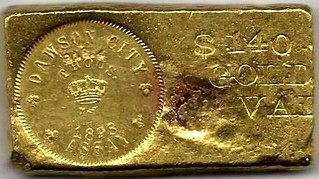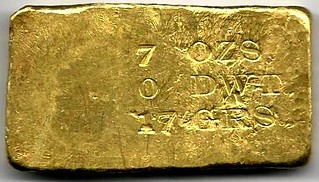
PREV ARTICLE
NEXT ARTICLE
FULL ISSUE
PREV FULL ISSUE
FALSE WESTERN AND DAWSON CITY GOLD BARS
The July 2015 issue of The Alaskan Token Collector &Polar Numismatist edited by Dick Hanscom leads off with an article by Bob Leonard on the false Western bar controversy in general, and the Dawson City, Yukon Territory gold bars in particular. With permission, here's a complete reprint. Thanks!
-Editor
FALSE WESTERN (AND DAWSON CITY, Y.T.) GOLD BARS


On March 16, 1996 the American Numismatic Society presented T.V. Buttrey with the Huntington Medal in recognition of outstanding achievement in numismatic scholarship. As is customary, he delivered a lecture, though not on one of his usual themes: “False Western Gold Bars,” published with revisions in the American Journal of Numismatics 9, 1997. In this outspoken critique of an entire genre, he condemned as modern fantasies all Western gold bars that came to market since the early 1950s, the Central America bars excepted: “...it is my personal judgment that the western American gold bars which began to appear in the 1950s are false, all of them, and that they are twentieth-century fabrications contrived to appeal to our interest in the history of the American West.” To say that this shocking charge was controversial would be an understatement. When Ted Buttrey told me this at the International Numismatic Congress in Berlin in 1997, I couldn’t believe him. All of them? Surely some were genuine. I accepted that many were bogus, but thought that some, at least, must be original. But I became convinced he was right, and he has finally convinced nearly everyone. One thing that delayed acceptance of his position was that these bars had been sold as genuine by all the leading dealers in the United States: John J. Ford, Jr.; Stack’s; Bowers &Merena; Kagin; NASCA; Rarcoa; and Superior. They were listed in Donald H. Kagin’s Private Gold Coins and Patterns of the United States and some were even included in the “Red Book” for a time. All these dealers objected to Buttrey’s thesis strenuously, and Ford had previously threatened to sue anyone who rejected them as fake. (He successfully prevented Buttrey’s previous article on this subject, “False Mexican Colonial Gold Bars,” from being published in the United States, where they were being sold, and it had to run instead in Academia Mexicana de Estudios Numismaticos.) Some dealers responded with a paper by Michael Hodder, a consultant for Stack’s and an acolyte of Ford, at the ANS Groves Forum, April 10, 1999. Hodder attempted to refute Buttrey by first questioning his qualifications (a big mistake) and then changing the subject from “gold bars” to “assay bars.” I responded to this with a Guest Commentary in Coin World, May 17, 1999, exposing this as a “straw man” argument; the mixed metal assay bars were noncontroversial and outside the group Buttrey condemned. Even Hodder admitted that some of the gold bars were of questionable authenticity, but I could not bring myself then to believe that Buttrey was right to condemn them all. In an ad in Coin World, July 12, 1999, Stack’s - who had a lot to lose if all the gold bars they had sold over the years were exposed as phony - challenged Buttrey to a debate on the subject of “western assay bars” at the 1999 ANA Convention in Chicago, with Michael Hodder representing them. Buttrey accepted the challenge, setting the stage for the “Great Debate.” It was held August 12, 1999 in front of a large audience (both Buttrey and Hodder mentioned me, Buttrey in his presentation, Hodder acknowledging that I was present). While Buttrey laid out the reasons for doubting the authenticity of the gold bars, showing an error in Hodder’s paper and proving the so-called Brother Jonathan bars were fake, his anger and arrogance - particularly his personal attacks on John Ford and Michael Hodder and announcement of a lawsuit - turned the audience against him, and Hodder could be said to have won the debate. However, others present, particularly Central America curator Bob Evans and Western mining expert Fred Holabird, were satisfied that the gold bars were bogus, and began writing articles and giving presentations exposing the falsity of one piece after another. Former ANS curator of United States coins John Kleeberg prepared a website with Buttrey, “How the West Was Faked” (http://www.cawa.fr/IMG/pdf/ how.pdf), which laid out the case against authenticity in great detail. John Ford became ill, and his library and correspondence came on the market, some of which was very revealing. Researcher and author Karl V. Moulton studied this correspondence and published a magisterial work, John J. Ford and the “Franklin Hoard” (the author: 2013). Q. David Bowers read the manuscript for this book and was convinced he had been “had” by Ford. Don Kagin, working on a second edition of Private Gold Coins and Patterns of the United States, wanted to purge his book of the many fakes he had ignorantly included, and began hosting panels at ANA conventions to discuss particular items. Buttrey and Kleeberg had accused John Ford of orchestrating the gold bar fraud, using his associate Paul Franklin (called Gerow Paul Franklin by Moulton to distinguish him from his son, also named Paul Franklin) to make them (“How the West Was Faked”). However, Moulton is not convinced (though he may have tempered his views because he depended on the cooperation of Paul Franklin’s son); he suggests the possibility of other forgers supplying Franklin. Paul Franklin did admit to making a few fantasy items for Ford at different times, though. So it may well be that Ford, who thought that he was smarter than anyone, may himself have been the dupe (at least for a time); if so, then Paul Franklin’s letter to him of November 23, 1964 was possibly the greatest communication ever made by a confidence man to his mark. In it, Franklin claimed that no one he had sold a coin to had ever returned it, but admitted that his activities had led him to being accused of operating the “Massapequa Mint” (he lived in Massapequa, NY, for a time) and said that he was being unjustly ridiculed and defamed. In any case, it certainly worked; Ford responded on December 1, stating “I realize that it was written from the heart.” He also indicated that he still had confidence that the “Franklin Hoard” of U.S. Assay Office of Gold double eagles, then under attack, was genuine, and asked Franklin to investigate further. (These coins were condemned by ANA authenticator J.P. Martin in 1994 and were positively proven false in a Pioneer Gold Forum sponsored by Kagin’s at the 2008 ANA convention.) Whoever made them, all these fake gold bars passed through the hands of one man: Paul Franklin. While a Paul Franklin pedigree is not a sure-fire sign of falsity, it does not inspire confidence. In the summer of 1955 he returned from a trip to the West with several items that were previously unknown (as were all his offerings): among these were an Adams &Co. $54.33 gold ingot, 1851; a James King of William $20 gold piece (also supposed to have been made in 1851); and a $140 Dawson City, Y.T. gold ingot dated 1898 (Moulton, p. 255). The James King of William $20 ingot is illustrated in the 13th edition of A Guide Book of United States Coins, 1960 (the Red Book), and - despite having a loop attached, as though it had been preserved by being made into a fob - has no chance of being authentic; the name is given as “Jas. King of William &Co.,” but King never used this style: he was always “James King, of Wm.” (Evidently the forger read about King in a history of San Francisco without realizing his business style; besides his personal name being rendered wrong, there was no “& Co.” either.) Also, he was a banker, not an assayer, and would never have issued an “assay bar.” As for the Adams and Dawson City bars, in each case the value is incorrect. The Adams &Co. bar is stamped 57 1/12 DWT $54.33, .881 fine. But this weight of gold would be worth that much only for a gold value of $21.61/oz.; its true value would be $51.98. The “Dawson City, Y.T.” bar is even worse: $140 Canadian = $140.00 U.S. at the time. The ingot is said to weigh 7 OZ. 0 DWT 17 GRS, or 7 x 480 = 3360 grains + 17 grains = 3377 grains. It is supposedly only .9184 fine, so it contains only 3101.44 grains of pure gold. (I will ignore the silver because the fineness is so high.) Dividing by 480 (the number of grains per ounce), we have 6.46 oz. pure. Multiplying by 20.6718 (the official gold price) gives $133.57, not $140.00. So this ingot “carries its own credentials” - as a fake. Here the gold is calculated on a value exactly $1 per ounce too high - $21.67. Obviously the forger forgot what the gold price was then, using two similar, but different prices for the Adams and Dawson ingots. These are among 28 bars with incorrect valuations. Genuine bars are normally accurate pretty much to the cent. John Ford paid $450 for the Dawson $140 bar, then sold it to the Norwebs for $5,250 August 21, 1955 (Moulton pp. 257, 263) - a nice profit. A second “Dawson City, Y.T.” bar exists (Scott A. Simpson and Leslie C. Hill, Yukon Trade Tokens, Vancouver Numismatic Society, 1979, p. 22). This is overdated 1899/8, with a value of $130 and with an additional counterstamp of the Dawson branch of the Bank of British North America. This bar is not in “How the West Was Forged,” and Simpson and Hill do not give a weight, so the accuracy of the value shown cannot be checked. But the additional counterstamp is a touch found on other Paul Franklin bars: many of the false Mexican Colonial bars bear an additional counterstamp (of impossible date), and the Argenti &Co. bar he sold has additional counterstamps of A. Humbert, assayer and Schulz & Co. To summarize: The Dawson City, Y.T. 1898 gold bar was sold with a group of California gold bars dated a half century earlier by the man who supplied all of the gold bars denounced by Ted Buttrey and others. There is nothing to connect it to Canada or the late 1890s. And the value stamped is based on a gold value $1 per ounce too high. It is a Paul Franklin fantasy of 1955. Sources: Kagin, Donald H., Phd.; Private Gold Coins and Patterns of the United States, 1981. Kleeberg, John M., How the West was Faked: False Western Gold Bars and other Forgeries ( http://www.cawa.fr/IMG/pdf/how.pdf). Moulton, Karl V.; John J. Ford and the “Franklin Hoard”, 2013. Simpson, Scott A. and Leslie C. Hill, Yukon Trade Tokens, Vancouver Numismatic Society, 1979. Dick Hanscom wrote in the issue: To say I was surprised to learn that the Dawson City gold bars were fake (fantasy, fabrication, false - take your pick), would be an understatement. I had heard of the Ford-Franklin controversy, but had not heard that the Dawson City ingots were part of that group. Robert Leonard has done a nice job documenting their connection, and pointing out their inadequacies. Wayne Homren, Editor The Numismatic Bibliomania Society is a non-profit organization promoting numismatic literature. See our web site at coinbooks.org. To submit items for publication in The E-Sylum, write to the Editor at this address: whomren@gmail.com To subscribe go to: https://my.binhost.com/lists/listinfo/esylum All Rights Reserved. NBS Home Page Contact the NBS webmaster 
|